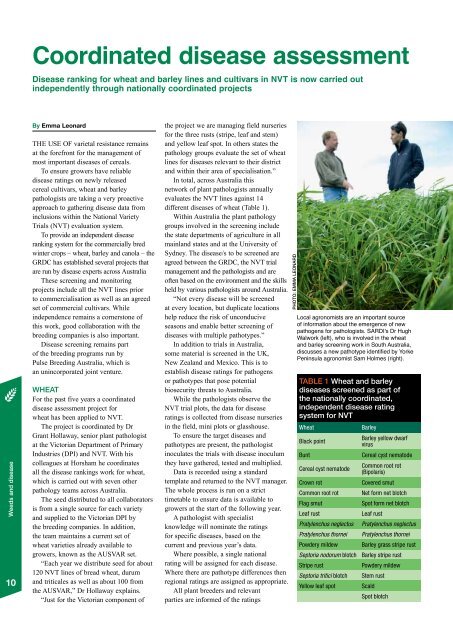NatioNal variety trials supplemeNt - Grains Research ...
NatioNal variety trials supplemeNt - Grains Research ...
NatioNal variety trials supplemeNt - Grains Research ...
You also want an ePaper? Increase the reach of your titles
YUMPU automatically turns print PDFs into web optimized ePapers that Google loves.
Coordinated disease assessment<br />
Disease ranking for wheat and barley lines and cultivars in NVT is now carried out<br />
independently through nationally coordinated projects<br />
Weeds and disease<br />
10<br />
By Emma Leonard<br />
The use of varietal resistance remains<br />
at the forefront for the management of<br />
most important diseases of cereals.<br />
To ensure growers have reliable<br />
disease ratings on newly released<br />
cereal cultivars, wheat and barley<br />
pathologists are taking a very proactive<br />
approach to gathering disease data from<br />
inclusions within the National Variety<br />
Trials (NVT) evaluation system.<br />
To provide an independent disease<br />
ranking system for the commercially bred<br />
winter crops – wheat, barley and canola – the<br />
GRDC has established several projects that<br />
are run by disease experts across Australia<br />
These screening and monitoring<br />
projects include all the NVT lines prior<br />
to commercialisation as well as an agreed<br />
set of commercial cultivars. While<br />
independence remains a cornerstone of<br />
this work, good collaboration with the<br />
breeding companies is also important.<br />
Disease screening remains part<br />
of the breeding programs run by<br />
Pulse Breeding Australia, which is<br />
an unincorporated joint venture.<br />
Wheat<br />
For the past five years a coordinated<br />
disease assessment project for<br />
wheat has been applied to NVT.<br />
The project is coordinated by Dr<br />
Grant Hollaway, senior plant pathologist<br />
at the Victorian Department of Primary<br />
Industries (DPI) and NVT. With his<br />
colleagues at Horsham he coordinates<br />
all the disease rankings work for wheat,<br />
which is carried out with seven other<br />
pathology teams across Australia.<br />
The seed distributed to all collaborators<br />
is from a single source for each <strong>variety</strong><br />
and supplied to the Victorian DPI by<br />
the breeding companies. In addition,<br />
the team maintains a current set of<br />
wheat varieties already available to<br />
growers, known as the AUSVAR set.<br />
“Each year we distribute seed for about<br />
120 NVT lines of bread wheat, durum<br />
and triticales as well as about 100 from<br />
the AUSVAR,” Dr Hollaway explains.<br />
“Just for the Victorian component of<br />
the project we are managing field nurseries<br />
for the three rusts (stripe, leaf and stem)<br />
and yellow leaf spot. In others states the<br />
pathology groups evaluate the set of wheat<br />
lines for diseases relevant to their district<br />
and within their area of specialisation.”<br />
In total, across Australia this<br />
network of plant pathologists annually<br />
evaluates the NVT lines against 14<br />
different diseases of wheat (Table 1).<br />
Within Australia the plant pathology<br />
groups involved in the screening include<br />
the state departments of agriculture in all<br />
mainland states and at the University of<br />
Sydney. The disease/s to be screened are<br />
agreed between the GRDC, the NVT trial<br />
management and the pathologists and are<br />
often based on the environment and the skills<br />
held by various pathologists around Australia.<br />
“Not every disease will be screened<br />
at every location, but duplicate locations<br />
help reduce the risk of unconducive<br />
seasons and enable better screening of<br />
diseases with multiple pathotypes.”<br />
In addition to <strong>trials</strong> in Australia,<br />
some material is screened in the UK,<br />
New Zealand and Mexico. This is to<br />
establish disease ratings for pathogens<br />
or pathotypes that pose potential<br />
biosecurity threats to Australia.<br />
While the pathologists observe the<br />
NVT trial plots, the data for disease<br />
ratings is collected from disease nurseries<br />
in the field, mini plots or glasshouse.<br />
To ensure the target diseases and<br />
pathotypes are present, the pathologist<br />
inoculates the <strong>trials</strong> with disease inoculum<br />
they have gathered, tested and multiplied.<br />
Data is recorded using a standard<br />
template and returned to the NVT manager.<br />
The whole process is run on a strict<br />
timetable to ensure data is available to<br />
growers at the start of the following year.<br />
A pathologist with specialist<br />
knowledge will nominate the ratings<br />
for specific diseases, based on the<br />
current and previous year’s data.<br />
Where possible, a single national<br />
rating will be assigned for each disease.<br />
Where there are pathotype differences then<br />
regional ratings are assigned as appropriate.<br />
All plant breeders and relevant<br />
parties are informed of the ratings<br />
photo: Emma Leonard<br />
Local agronomists are an important source<br />
of information about the emergence of new<br />
pathogens for pathologists. SARDI's Dr Hugh<br />
Walwork (left), who is involved in the wheat<br />
and barley screening work in South Australia,<br />
discusses a new pathotype identified by Yorke<br />
Peninsula agronomist Sam Holmes (right).<br />
Table 1 Wheat and barley<br />
diseases screened as part of<br />
the nationally coordinated,<br />
independent disease rating<br />
system for NVT<br />
Wheat<br />
Black point<br />
Bunt<br />
Cereal cyst nematode<br />
Crown rot<br />
Common root rot<br />
Flag smut<br />
Leaf rust<br />
Pratylenchus neglectus<br />
Pratylenchus thornei<br />
Powdery mildew<br />
Septoria nodorum blotch<br />
Stripe rust<br />
Septoria tritici blotch<br />
Yellow leaf spot<br />
Barley<br />
Barley yellow dwarf<br />
virus<br />
Cereal cyst nematode<br />
Common root rot<br />
(Bipolaris)<br />
Covered smut<br />
Net form net blotch<br />
Spot form net blotch<br />
Leaf rust<br />
Pratylenchus neglectus<br />
Pratylenchus thornei<br />
Barley grass stripe rust<br />
Barley stripe rust<br />
Powdery mildew<br />
Stem rust<br />
Scald<br />
Spot blotch

















